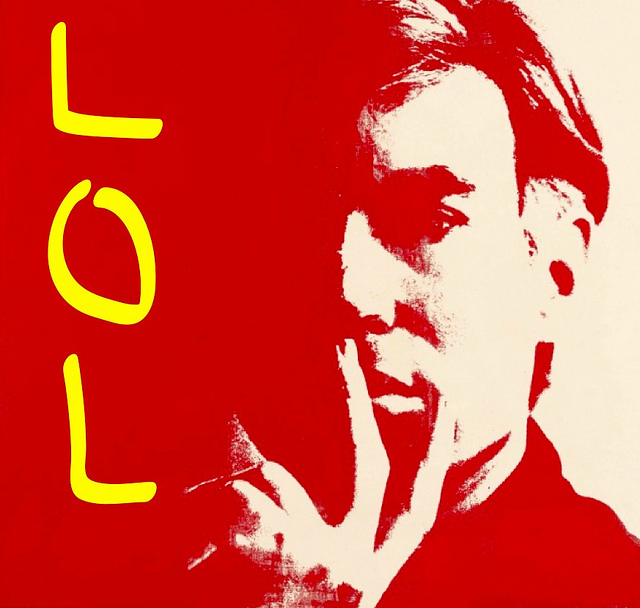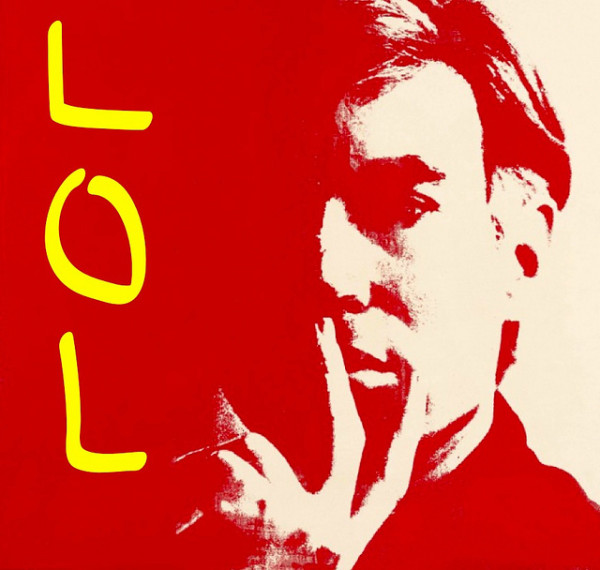
By AE Fogg*
In 2012, The Andy Warhol Foundation for the Visual Arts consigned a collection of works to Christie’s. A catchy Andy Warhol @ Christie’s logo soon emblazoned the pages of press releases and catalogues, its four-part design and poppy aesthetic referencing Warhol’s multi-paneled works—his signature screen print series and lesser-known stitched-together photographs. (Full disclosure: I’m an employee at Christie’s.) The partnership became a freestanding brand for which Christie’s had a multi-fold plan: to hold live auctions, conduct private sales, and roll out a series of online auctions to raise revenue for the Foundation and reanimate Andy Warhol’s legacy. The project’s marketing strategy may seem fitting for selling off Warhol’s inventory—to make colorful and compelling the cultish and commodity-driven culture Warhol documented.
The latest of these online auctions, Andy’s Eye Candy, featured 117 photographs, prints, and drawings, and ran from May 29 to June 10, in conjunction with LGBT Pride month. If we look to the past auction season as an indicator, Warhol’s current market value is incredibly high. In May 2014, Christie’s raked in a historical high of $975 million, a dizzying number that could be attributed in part to Warhol’s “Race Riot”—sold for $62.8 million to Larry Gagosian—and “White Marilyn”—sold for $41 million.
Online auctions, though, feature cheaper lots and more diverse content.
The eCommerce experience is a markedly odd one: as viewers scroll through lots, they find red-bannered countdowns—2 Days | 20 hours | 35 minutes | 42 seconds—and the option to pin! their favorite works. Hovering over each cluster of pixels, one can click, view and bid, then click again, and with a slight tap of a finger, digitally drop $12,000. Easy money, easily spent.
The works featured in Andy’s Eye Candy explore the subjectivity and performative aspects of gender and sexuality.
Conditions of online sales are quite different than traditional live auctions. For one, there are no glossy marble floors to traverse, no besuited characters ambling around complimentary treat tables. No Jussi Pylkkanen to narrate the sale and direct auction results with the flick of the wrist or a slight change in posture. There is little in the way of hierarchical seating arrangements, and the social divisions of live bidders to phone bidders to online bidders dissipates. Most bizarrely, the experience of time in the digital marketplace is categorically different from that of a traditional auction. In a live room, the highest bidder can (and does) change in 20 seconds, whereas in the digital marketplace bidders can sit on a lot for 24 hours, or in this sale, 13 days. Finally, bidders worldwide can access the sale, granted their country’s censorship laws permit e-bidding.
The works featured in Andy’s Eye Candy explore the subjectivity and performative aspects of gender and sexuality. They make visible a range of identities that, despite an expanding cultural consciousness about gender and sexuality, often remain contained and neatly packaged in their appropriate binaries.
In one print, Matisse-esque flecks of color cascade across a model’s face, obfuscating her/his features. The model’s gender is ambiguous, but the gestural curve of his/her wrist and sheen of her/his lips could be perceived as feminine. The title of the work, Ladies and Gentlemen, suggests that the model can be both a lady and a gentleman at once—therefore challenging a heteronormative system that promotes cisgendered dress and behavior. This lot sits quite comfortably next to a slew of other photographs and prints of transgender or crossdressing subjects (many are similarly named Ladies and Gentlemen, but feature different subjects).
A series of portraits of Jackie Curtis from 1974, meanwhile, shows a range of looks—simultaneously posed and candid, performative and natural. Her look could be described as glamorous and deviant: penciled brows, darkly stained lips, heavy lids hanging with mascara. She grins devilishly in one shot, then coyly in the next, as her lacquered nails wrap elegantly around a lit cigarette. In Warhol’s diaries he fluctuates with which gender pronoun to attach to Curtis, often using she and he interchangeably within the same sentence. This indicates that socially accepted categories for sex and gender are not inherent or static, but rather unstable, socially-specific, and subject to change.
Two prints of Shaun Cassidy estimated to sell for $4,000-6,000 sold for $3,250. In these works, a young Cassidy stands coolly in front of an Yves Klein-blue backdrop, his face cocked slightly to the side. The outline of a figure—presumably a stylist or assistant on deck—reaches out to slick back Cassidy’s hair. His tie is left sexily askew; his expression is insouciant. In a diary entry from August 1978, Warhol writes: “Shaun just turns into something else when he’s being photographed, something just happens to him, he just falls in love with himself.” This observation sheds light on how the construction of an image—in this case Cassidy as a desirable star—is highly specific per social conditions. The way male desire functions here—as projected, internalized, and intimately tied to fame—is significant, as it shows the strength of the male gaze.
In an especially pointless post, fashion it-boy Derek Blasberg is asked, “What or who would be Andy’s muse if he were alive today?” His answer: “Jeez, probably Lindsay Lohan.”
Finally, in a silver gelatin print aptly titled Benjamin Liu Eating a Banana, the longtime assistant to Warhol jams a banana into his mouth. Bananas, that most Warholian symbol, pop up all over the sale, and seem especially priapic in an auction featuring many photos and drawings of penises. As food they provide nourishment and growth, and as phallic forms they suggest sexual arousal and male desire. These photographs become vehicles for that double-meaning, and in many ways, the literal manifestations of it.
The works sold in Andy’s Eye Candy sale could be part of a significant conversation around LGBTQ identities and the performance of gender. Of course, given that our point of access to these works is Christie’s—a marketplace driven by sales—we shouldn’t be surprised if engagement with those issues is limited. But the reality is disappointing, even with expectations tempered.
A website especially dedicated to the Warhol @ Christie’s project uses blog-like content to promote sales, featuring sections like Andy Warhol Quotes and Warholian Questionnaires. It includes headlines like It’s a man’s world for pieces that read like click bait: 11 Male Nudes from Art History. People targeted as relevant to this project—Justin Vivian Bond (a “trans-fabulous performance-activist”), Tabitha Simmons (Stylist and designer), Leandra Medine (Fashion blogger), and Lena Dunham (Writer, director, actress)—have answered a series of Warhol-themed questions in one section. In an especially pointless post, fashion it-boy Derek Blasberg is asked, “What or who would be Andy’s muse if he were alive today?” His answer: “Jeez, probably Lindsay Lohan” (Dunham agreed).
The underlying intent here is hardly inconspicuous: to use social media to connect the who’s who of today with cultural icons featured in Warhol’s inventory in order to show the continuous nature of celebrity cultishness. But while the website may be successful in appealing to a younger, more digitally focused audience, its content is reductive and overly simplistic, even without considering the work its promoting. When one does consider that work, The Warhol @ Christie’s site also becomes a sorely missed opportunity to bring light to LGBT issues and fuel a conversation around sexuality and power. As works from Andy’s Eye Candy are pinned to users’ pinterest boards, culled for press releases, and in 117 cases, absorbed into collections around the world, they will inevitably take on new social meanings. Some works will be valued as nuanced representations of individuals exploring their identities—identities that are transgressive and that challenge the dominant mainstream. Still, other works—by nature of the point of entry being Christie’s—will be valued as investments of monetary and social significance. Both outcomes, it seems, would be amusing to Warhol.
*This article was published under a pseudonym
AE Fogg is a writer living in Brooklyn, New York.

